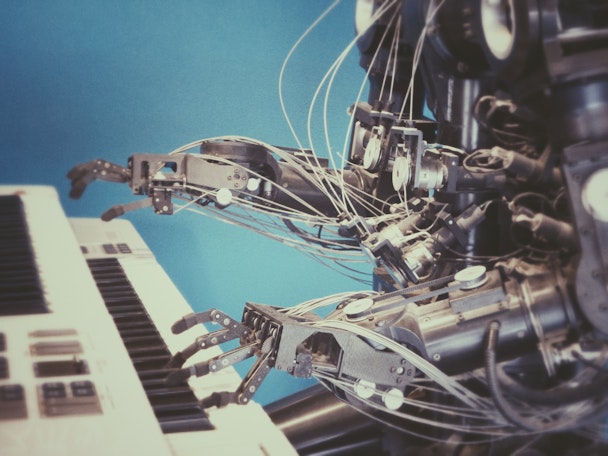5 creative inspirations AI will never understand
Are robots coming for all our jobs? Maybe. But in the meantime, DRPG’s Tommy Joe Moore argues that there are five facets to creativity where silicon still can’t compute with grey matter.

Are there still some things that we humans can do and AI can’t? / Possessed Photography via Unsplash
Defining creativity is like trying to catch a cloud with your bare hands: elusive, ever-changing, and usually just out of reach. Despite that, we all know what creativity is when we see it. And we can all understand its value when we feel it.
Creativity, in some shape or form, sits at the heart of every advert that’s ever made a real impression on you, every marketing strategy that’s had you clicking ‘buy’, and every event that’s left you talking about the same few hours for days on end. It’s an essential skill for anyone in marketing and media, and it gets results.
If you value creativity (and if you’re reading this, you probably do), you’ll surely have noticed how artificial intelligence is starting to take up more and more space in the worlds we creatives inhabit. But can it match our skills?
Advertisement
In some ways, yes. It can churn out words faster than me and whip up some weird and wonderful imagery too. It can smooth processes, provide answers and enhance our day-to-day in a million different ways. But it can’t think and invent as we do. Creativity, in its purest form, is an embodiment of the human spirit and imagination. It is an outpouring of emotions, ideas, and experiences that defy logical boundaries. And while robots can mimic, replicate, and iterate, there are aspects of the creative process that remain exclusive to human ingenuity.
The ability to conceive show-stopping ideas remains firmly in our domain, for now at least. So here are five prime examples of what the robots can only aspire to master.
Advertisement
1. Change and problem-solving
Author and marketing strategist Seth Godin says, “The job isn’t to catch up to the status quo; the job is to invent the status quo.” This highlights one of the key limitations of AI: that it builds every response from an established norm. Humans, in contrast, possess the flexibility to approach challenges from multiple angles, adapt their thinking in response to new information, and embrace ambiguity. That’s the key to overcoming creative hurdles and challenging the status quo.
2. Emotion and empathy
“I love dogs. But I can never understand, fully, what it is to be a dog. So too with AI,” explains Ruan Sarris, creative director here at DRPG. “An AI will never be me. Or us. It will never have pain, never know sadness, loss, hunger or poverty. Only by knowing, truly knowing, can you tell a good story. So, for me, the robots will never have the empathy needed to be a truly good creative.”
AI can make a good photocopy of empathy, but only a soul can know a soul. And a good creative story speaks from soul to soul. Drawing from human experience, that’s what you need to do to land your message well.
Suggested newsletters for you
3. Context and connection
Creativity flourishes when it is deeply rooted in our cultural and social context. We connect with messages that speak to what’s happening around us, and it’s tricky for algorithms dealing in fact to get that nuance just right. It’s different for people, as Steve Jobs, Apple’s co-founder explained: “Creativity is just connecting things. When you ask creative people how they did something, they feel a little guilty because they didn’t really do it, they just saw something. It seemed obvious to them after a while. That’s because they were able to connect experiences they’ve had and synthesize new things.”
4. Imagination and invention
Our capacity to envision entirely new worlds, scenarios, and concepts sets us apart from our robotic counterparts. While AI can generate variations and combinations based on existing data, it cannot fathom the uncharted territories of imagination that lead to revolutionary breakthroughs. Or, as Albert Einstein said, “Imagination is more important than knowledge. Knowledge is limited. Imagination encircles the world.”
5. Chance and intuition
Not every decision that a creative makes is rooted in fact. “Sometimes you just have a hunch for what will work and what won’t, and that’s not really something that can be explained or quantified in simple terms,” says Nick Fagen, creative technologist at DRPG. “Intuition is really powerful and so often it comes from years of experience and a unique combination of experiences over a lifetime. To me, there’s just no way an AI, with its logical frameworks, can replicate the gut feeling that guides creatives towards uncharted territories (and some of the best ideas!)”
As we gaze into the uncertain future, where AI’s capabilities continue to expand, there’s plenty humans still do best. While machines can simulate creativity to a remarkable degree, they are bound to frameworks and algorithms that just don’t allow for that vital spark. Speaking for us though, we’ve got creativity in spades. So, let’s get it out into the world.
Content by The Drum Network member:

DRPG
DRPG is one of the longest established, trusted and uniquely integrated communication and production specialists, famous for making anything possible as we connect...
Find out more
